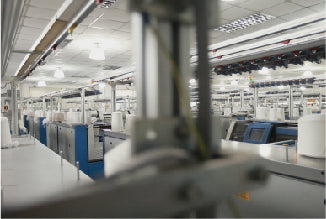● Introduction
The peace and quiet in SAND RIVER’s factory in the Jinshan district of Shanghai will leave you impressed when you enter the factory premises. You will find that there is very little noise in the factory. The textile equipment is monitored by the factory workers. To ensure the high quality of the finished products, the products are inspected by certified inspectors. Both the workers and the inspectors treat the products very carefully as if they were intricate art pieces.

●Automatic production
The factory uses high-quality mechanical textile technology with almost 100 German Stoll high-precision textile machines installed in the building. The factory takes environmental sustainability very seriously so the equipment used is low-carbon and environmentally friendly. The equipment is energy efficient as well and consumes very little energy. It is also very quiet, which helps with the peace of mind of the staff working there as well.
The factory is highly automated. You may not see many workers around in the working area. Most of the operations are automated and the workers only have to keep an eye on the operating machine. One person can easily monitor up to ten machines. If there is a problem with one of the links of the production chain, the production is stopped and the products are produced again after the fault has been fixed. This idea of identifying the faults as quickly as possible and fixing them at the stage where they are found is known as the lean production concept. The founder of SAND RIVER, Juliet Guo, insists on following this concept and ensuring that no defective product goes on to the next step of the process without being fixed.

The fabrics produced at SAND RIVER are artistic and beautiful. They are made using automatic equipment which is programmed by designers. Their beautiful and aesthetic designs are brought to life by this automatic equipment. Converting the amazing designs into a programming language that can be recognized by the machines is a daunting task that requires a great deal of research, development, and investment.
This need is clearly realized and fulfilled by SAND RIVER. It has a high-tech Research and Development center with the help of which a perfectly ordered connection between the craftsmen and the automation equipment is established. SAND RIVER has always been proud of its most advanced automation equipment.

●Strict QC
Every process that takes place in SAND RIVER is highly precise and so is the QC (Quality Control). The founder Juliet Guo insists on quality control and makes sure it is practiced at SAND RIVER. She is highly aware of the importance of lean manufacturing. She has lived and studied in Germany, and stresses that having no flaws in the products, means two things. Firstly, there is no waste, and secondly, this, in turn, makes the product environmentally friendly.

If there is even one problem, there is a good chance that it will affect the processes that are to follow. Even a single wrongly placed thread can lead to the whole cloth being wasted. If there is an issue in any of the processes, it needs to be fixed there and then in a timely manner. The flawed product is not allowed to enter the next process in the chain. By doing this, product quality of the highest levels is ensured.
The founder Juliet Guo is of the belief that a number of manufacturing brands produce substandard products. She says that so many resources are dedicated to making the product such as raw material, labor etc. and yet the finished product turns out to be unqualified. Cashmere is very precious as it takes five lambs to produce enough for one garment. This cannot be wasted and that is why SAND RIVER focuses on controlling the processes from the very beginning. Juliet Guo believes that doing this may cost a little extra, but in the end, it’s definitely worth the cost.
Every worker in the SAND RIVER factory is involved in quality control and is a member of the QC team. If you talked to the employees, you would come to realize that they also believe that this is the best possible way. They take the responsibility that is bestowed upon them very seriously as they think it is the right way to work.
●Yarns are carefully controlled to every meter
The policy of SAND RIVER’s factory is zero wastage of cashmere yarn. Any material that remains on the assembly line, the outdated inventory clothing and any other piece of yarn will be recycled. Even one-meter long threads of yarn will not be discarded. A single meter of the thread is 1/20 times of the amount of cashmere yarn produced by a lamb annually. People at SAND RIVER factory believe that such high-quality raw material needs the best possible treatment. Every employee working on the production line is convinced of this and so will collect and not discard any yarn that remains on the assembly line for recycling.
The founder Juliet Guo is very proud of the fact that the factory is striving to reach the goal of zero wastage. Compared to the processes used in the SAND RIVER factory, traditional processes waste almost fifteen to twenty percent of fabrics or fibers.

●The artisan's repair skills
A purple cashmere coat, which was launched approximately 3 to 4 years ago, was being repaired with a craftsman working deftly in a corner. SAND RIVER provides repair services for their customers as well.
When after use, cashmere clothes have holes or start losing threads, most consumers put them away in boxes at the bottom of their cupboards. They have no choice since they can no longer use their favorite cashmere products in their current state. This is quite wasteful. However, SAND RIVER provides a repair service to their customers so that the valuable cashmere clothing will not go to waste and will have a longer life after the repair.
Next to the worker there stood a bag which was filled with the yarn that remained from the assembly line. Before repairing a piece of clothing, the worker would first think about the best method to repair it. After coming up with a method, she would go through the bag filled with yarn and find the most suitable thread. After that, she would start working with a thin crochet needle to repair the product in the best way possible.

The small hole in the purple cashmere cardigan was repaired by the skilled worker and it looked almost as good as new. It was perfectly wearable once more.
The interesting fact here is that this person is not a current employee of SAND RIVER. She used to work there, but had to leave because of family reasons. However, she liked the atmosphere of SAND RIVER and in her spare time, she would go to the factory and render her services whenever possible. In the era of machines, this crocheting skill is still very valuable.
●Transformation game: from oddments to dolls
The cashmere remains from the production line are used to repair cashmere fabrics, and are worked into gloves and hats, but they have another amazing usage as well. Craftsmen use these remnants to create beautiful cashmere dolls. The dolls are stuffed with the strings that are generated during the production. (the following picture shows this)

●A warm factory
Every employee participates and works meticulously in order to realize the goal of zero wastage at the SAND RIVER factory. Although it adheres to a rigorous system, the SAND RIVER factory doesn’t have a rigid environment. In fact, the factory is full of life, warmth, happiness, and kindness.
Using a precision instrument, different pieces of clothes are seamed together by a number of sewing workers in another part of the factory. This requires a highly demanding technique of matching every single needle eye of the precision instrument to each coil of material. These precision instruments have approximately 22 needles per inch. Operating these highly sophisticated instruments requires a high level of coordination between the right and left hands of the workers. (This is shown in the following picture)
Despite the fact that this is a daunting task, they do not seem to be troubled or solemn; they work in peaceful harmony and often discuss the next step to take with their co-workers.
During their spare time, the co-workers interact with each other in a friendly atmosphere. Those who possess good cooking skills bring in food such as cakes or snacks to lunch and share them with their fellow workers. A BBQ is held every Friday at SAND RIVER which creates further opportunities for the employees to communicate with each other.








